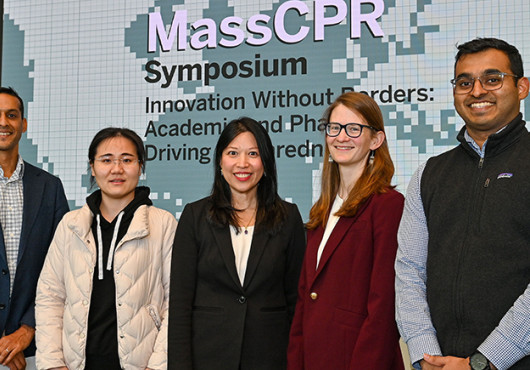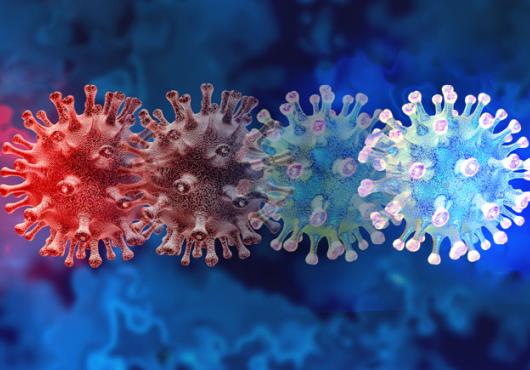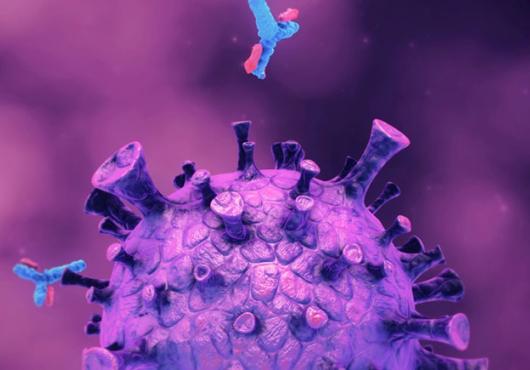
HMS instructor in medicine Amy Baughman, MD, at Boston Hope
In early April, as the first wave of the coronavirus pandemic began to crest in Boston, Jeanette Erickson noticed one night that she’d missed a phone call from Peter Slavin, president of Massachusetts General Hospital. She sent him a return text and, at 5:30 the next morning, he called her back.
That same week, Giles Boland had already gone to sleep one evening when he received a late, urgent call from his boss, Betsy Nabel, president of Brigham Health.
Both Boland and Erickson were told their help was needed immediately for what seemed like an impossible task.
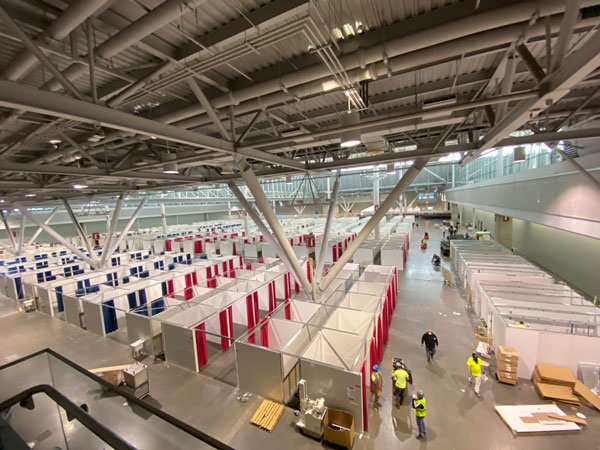
Anticipating a possible crush of COVID-19 patients that could overwhelm Boston-area hospitals, Massachusetts needed a 1,000-bed postacute-care hospital to be built and staffed in the city’s Seaport convention center — in one week.
Neither Boland, the Philip H. Cook Professor of Radiology at Harvard Medical School and Brigham and Women’s Hospital, nor Erickson, chief nurse emerita at Mass General, hesitated.
“Here’s a crisis,” said Boland. “This is a pandemic. This is our moment, as physicians, caregivers, nurses … this is what we were meant to be, at some level. When the world came to a stop and a health crisis came, what better sort of moment, if you will, that you could … deliver a desperately needed service for the patients and the community.”
“I wanted to help with COVID and this seemed like the right thing to do,” said Erickson, who is also an instructor in obstetrics, gynecology and reproductive biology at HMS. “For me it was a once-in-a-lifetime experience of seeing people’s values come together so quickly over the course of a week, to create this environment of care.”
Like scores of other HMS faculty and Boston-area health care professionals, the pair was about to embark on a professional experience unlike any they had ever known. They joined forces to serve in the fight against a deadly virus, becoming co-medical directors for the new facility, aptly named Boston Hope Medical Center.
Over the next few months, Boston Hope would successfully provide care to more than 700 subacute patients who had COVID-19 or were recovering from it. A significant portion of those patients came from Boston’s homeless population and roughly half of the patients spoke only Spanish.
If we build it …
“We realized early on … that [COVID] was probably going to hit the shelter community like a ton of bricks,” said James O’Connell, president of Boston Healthcare for the Homeless Program, an organization whose clinicians, since the mid-1980s, have had extensive experience responding to outbreaks of communicable diseases such as tuberculosis, H1N1 and HIV, among the populations they serve.
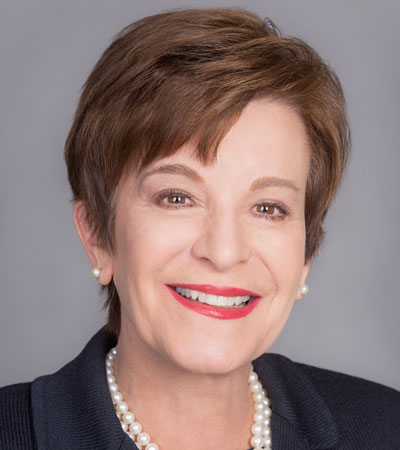
Still, he said, “The thought of how to pivot and take care of a lot of people with COVID when we have so many other sick people was a little scary, and I think every hospital in every system was facing that [fear].”
An HMS Class of 1982 alumnus and an assistant professor of medicine at Mass General, O’Connell and his team began working with the city to administer COVID tests to residents of area shelters.
The team’s members became concerned when they discovered 35 percent of all shelter guests tested positive for coronavirus in April, and almost 90 percent had no symptoms at the time they were tested. At the Pine Street Inn, another large Boston shelter, a similar percentage would equal close to 150 people. O’Connell knew they were going to need a place to isolate and care for COVID-positive residents, and he was relieved when the city both offered and asked for help.
“We were thrilled to be able to do that. … Managing a 500-bed medical step-down hospital was going to be a little bit of a stretch, but it turned out to be a wonderful experience because we had so much help,” said O’Connell.
With construction crews working three 8-hour shifts a day, and Mass General Brigham, a coalition of 16 health care organizations, managing all administrative and clinical responsibilities, Boston Hope did materialize in just one week. Nine days after those first urgent calls went out, the hospital began admitting patients.
Failure was never an option, Erickson said, echoing the words of the head of the Apollo 13 moon mission.
“They understood the gravity of the situation and the potential for the [Boston] hospitals’ becoming overwhelmed, and the catastrophic nature of that,” said retired Brig. Gen. Jack Hammond, the executive director of Mass General’s Home Base Program. Hammond was recruited to lead build-out and operations for Boston Hope.
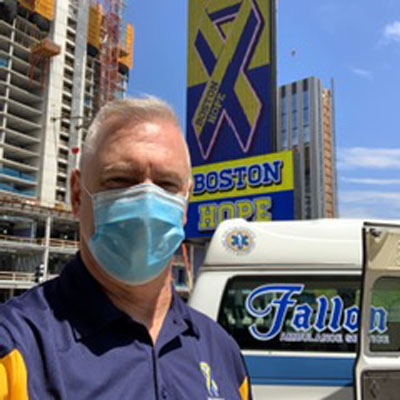
A 30-year U.S. Army veteran who served in both Afghanistan and Iraq, and commanded thousands of military personnel there, Hammond was tapped by Massachusetts Gov. Charlie Baker partly for his experience in responding to disasters, both human-caused and natural. But this, said Hammond, was different.
In those situations, he could count on responding with teams trained and ready to handle such emergencies. In this instance, he said, the state and the city were starting with nothing and no one. People, equipment and supplies were needed—and quickly.
Hammond asked Richard Ehrlichman, an HMS assistant professor of surgery and a plastic surgeon at Mass General with whom Hammond had served in Afghanistan, to join the effort. Ehrlichman, who is also a colonel in the Massachusetts National Guard and the U.S. Army Medical Corps, likened the project to a military operation. They first needed to determine the number of beds and then figure out how to procure monitors, provide patients with oxygen, find and install ventilators, arrange for food service and laundry facilities, stock a pharmacy and acquire PPE and bandages—everything necessary to care for patients.
But first, they needed to find staff.
“We just got to work after that, trying to figure out where do we recruit from, how do we find the people. As you can imagine, one of the biggest challenges was, you can’t rob Peter to pay Paul. The type of people that we needed were exactly the people the hospitals needed,” said Hammond.
A call for help went out and the response from the Boston health care community was inspiring. Personnel came from Boston-area hospitals, Boston Health Care for the Homeless, all HMS Boston-area teaching hospitals, Atrius Health, the Massachusetts Medical Society, various nursing schools and the MGH Institute of Health Professions.

They came from across eastern Massachusetts, according to Ehrlichman, who said there were close to 90 physicians in all—42 from Mass General, 23 from Beth Israel Deaconess Medical Center and 24 from Atrius Health. There were 309 nurses on staff, 42 of them student nurses. The Spaulding Rehabilitation Network also contributed physical and occupational therapists.
These personnel were joined by a U.S. Army Reserve medical battalion of 85 doctors, nurses, pharmacists, respiratory therapists and physical therapists.
Many area health care professionals furloughed by the COVID-19 pandemic offered to help. Like everyone pitching in to fight this new disease, they would all need to be trained in how to care for COVID-19 patients and how to practice related new safety protocols.
Kerri Palamara McGrath, an assistant professor of medicine at Mass General with expertise in primary care internal medicine, was one of those who answered the call to help. Within days she found herself, along with Amy Baughman, a hospitalist and HMS instructor in medicine at Mass General, supervising Boston Hope physicians.
“You … took a bunch of people who have never worked together before and threw them in a setting they’ve never worked in before, taking care of patients with a disease none of us have ever seen before,” said McGrath. “And we took amazing care of patients. We gave these people outstanding clinical care, which you would expect from any of our institutions, right? … People gave their heart and soul to being there.”
Having personnel to staff the hospital addressed only part of the problem. A technology infrastructure had to be set up along with a way to access electronic health records, and myriad other services had to be provided. Soon the hospital contained 1,000 beds, six acute care suites, 52 nurse stations, 48 bathrooms, physical therapy suites, a pharmacy and, over the course of several months of operation, approximately 1,000 health care workers.
McGrath’s and Baughman’s jobs involved communicating directives from leadership to the frontline clinicians working with patients on the wards.
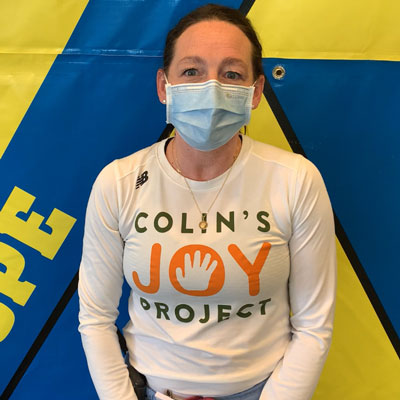
“Like, how could we make sure that [clinicians] knew all the policies and procedures, because the things changed so fast. In COVID time we say a day is a week, a week is a month, a month is a year, things change so fast. So, what we did for PPE one day, changed the next,” said McGrath.
“COVID care requires a completely new model of care in terms of PPE, patient-care ratios, training. It required a lot of thinking on your feet,” said Baughman.
For that reason, there were PPE trainers and a monitor working the floor at all times, ensuring that all safety requirements were stringently maintained and PPE conserved. These protocols were instituted by chief safety officer Matthew Hutter, HMS Class of 1995, a professor of surgery at HMS and Mass General.
“Generally, we were responsible for onboarding, orienting, standardizing the care and figuring out all of the care processes, and then a lot of the workflows, said Baughman. “Everything from ordering labs to how to properly order medications, to writing the discharge summary to ensuring that people are clinically appropriate at discharge. Just the whole gamut of things.”
Under normal hospital circumstances, that’s a big job. At Boston Hope, which relied on medical professionals trained in other specialties, it was a different ballgame. Many were outpatient clinicians being asked to do inpatient work.
“So, how do you teach an orthopedic spine surgeon to adjust insulin for a diabetic? We had a lot of that, where people had to learn not only entirely new processes, new EHR [electronic health records], but also clinical care. How do you do that safely? The answer is with a lot of support, and you embed them into a team of primary care docs … So, we figured out how to do that with great teamwork,” said Baughman.
Baughman acknowledged that her time at Boston Hope was one of the most stressful in her life, partly because she continued working her regular job at Mass General. But that dual access also allowed her to bring new COVID-19 information to the table at Boston Hope.
She said there were intense days wearing hot, uncomfortable masks for 12-hour shifts, and most clinicians minimized the number of breaks they took in order to conserve new and very scarce PPE, as gowns, masks and gloves had to be replaced after every break. She said that her discomfort was minimal, however, compared to what patients experienced.

“It’s sort of uncomfortable to wear a mask but getting COVID and having to isolate and be in this strange place with people wearing space suits is scary and stressful,” said Baughman.
McGrath said at various points more than half the patients there spoke only Spanish and there were challenges communicating through interpreter phones in the loud convention center, especially when both clinicians and patients were wearing masks and there was always the possibility of a patient having hearing difficulties in addition to a language barrier. To help facilitate communication, she said, they adopted a successful language care model from Mass General, which called for embedding a Spanish-speaking clinician in caregiver units.
Other challenges involved the shifting discharge protocols and making decisions about where patients would go upon release.
“Many people who were newly homeless because of their COVID situation, … it wasn’t safe to go back to their facility. Or their medical status was perhaps worse off now, … so, wherever they were before wouldn’t take them anymore,” McGrath said.
Although the discharge process would prove to be the most challenging aspect of caregiving for some of the clinicians, they were assisted by 16 case manager/social workers and 14 nurse case managers.
There were also 72 nurse practitioners at Boston Hope over the course of the three months, and because COVID-19 attacks the respiratory system, there were also 18 radiology techs and six respiratory therapists, along with more than 45 physical therapists, three speech pathologists, 35 pharmacists, seven dietitian/nutritionists and a psychiatrist and psychologist all serving on the wards.
The military teams also filled critical roles, Baughman said.
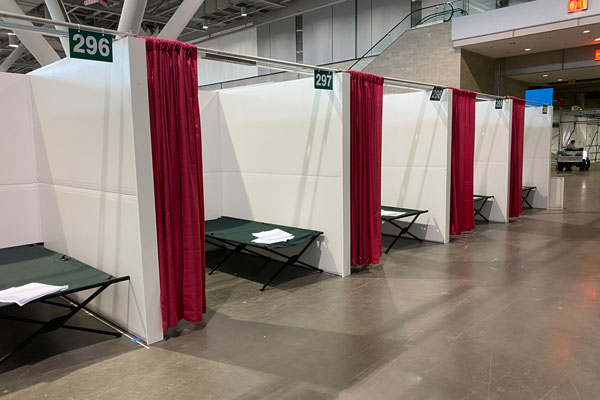
“We didn’t have unit secretaries. This is the person who is air-traffic control for the unit. We didn’t have people in that role for several weeks, so the military, their team filled that in. Respiratory therapists, they had three, which for COVID is the really big deal with a lot of people on oxygen. So they were able to fill in a lot of the cracks, which was fantastic,” she said.
To manage all the health care personnel, human resources staff was also required. Seventeen HR reps and eight business relations managers were on loan from Mass General Brigham. To handle the massive tech infrastructure that was needed, there were 20 network engineers available, as well as a telecom expert.
“People really came from different backgrounds, varied backgrounds, varied experiences, but everyone came really embracing the mission of Boston Hope,” said Erickson.
Said Hammond, “Some of the docs that came over to help train were already working acute care shifts at the Brigham, the BI and MGH, and had seen [COVID-19 effects] firsthand, and they knew what was happening. We knew we had a role to take pressure off the hospital systems … because worst thing you could ever have is, when the water goes over the bow and the ship starts sinking, when they’re overwhelmed, that means people are going to die.”
Innovation in a crisis
For Larry Ronan, an HMS instructor in medicine at Mass General, in addition to filling a critical health care need for the community, Boston Hope offered a rare educational opportunity. HMS physicians and faculty have a history of responding to medical emergencies during war time and disasters, Ronan said. He felt it was important to not only be a part of the HMS response team, but also to make sure HMS students had a chance to serve and learn.
“When something this important and significant happens, we want our people and our faculty there,” he said. “There are these large human events where people are suffering and what are we if we’re not responding to them?”

Ronan, an HMS Class of 1987 alumnus, worked with the School and with graduating HMS student leader Shivangi Goel to get the word out to students who were able to volunteer, and to iron out administrative obstacles to their participation. He felt the benefits would be great, both for students and the faculty supervising them.
“Wherever students are, we, the faculty, are made better,” said Ronan. “It ups our game and improves our care.”
Ronan and Ehrlichman created virtual didactic learning sessions with journal clubs and guest lectures on topics such as disaster management, rehabilitation and COVID-19 encephalopathy for the students.
Recent HMS graduate Selena Li, a California native now in her first weeks of a surgical residency at Mass General, was eager to sign up and gain additional clinical experience. She had planned to spend time in the spring working in a refugee camp in Greece, but COVID-19 put a stop to international travel and she was pleased to be able to redirect her efforts.
On a regular shift at Boston Hope, Li saw six to eight patients a day, completed rounds, wrote orders. In some ways, she said, it was not too different from regular hospital medicine, but in other ways, it was very different.
“The things that we were seeing clinically, because it’s such a new disease, we didn’t know a lot about how it was presenting, and what was normal or abnormal,” she said.

Performing physical exams while in full PPE for six or seven hours at a stretch was also difficult. Because of her work, Li also found herself isolating from friends to avoid contaminating anyone else while also practicing daily protocols on the job to protect herself. That, she said, was initially “nerve-wracking.” In the end, however, she found she felt safer at Boston Hope than she did out in the community because of all the stringent safety practices and equipment in place there.
Although some of the medical work was predictable, she found that her biggest lessons had less to do with caring for her patients’ bodies and more to do with helping to heal their hearts and minds.
“What I did notice was more of the social component of it … we were working with patients who had been isolated from people for up to a month and were seeing how that affected them psychologically,” she said.
“Having worked at Boston Hope,” she added, “you had to think really thoughtfully about where the person’s going and what services they will need … the things outside of medicine that make a person a person.”
Inkyu Kim, another HMS 2020 graduate now participating in an emergency medicine residency at Mass General and Brigham and Women’s, said he signed up to work at Boston Hope because he wanted to help during the pandemic and had been frustrated by stay-at-home orders that barred medical students from clinical work.
Like Li, he did not find the clinical work at Boston Hope — rounding on patients and performing exams — to be difficult. He had the training and experience for it. But the reality of how the pandemic had shattered some patients’ already fragile existences was eye opening. The social determinants of health in the U.S. were brought into sharp relief.
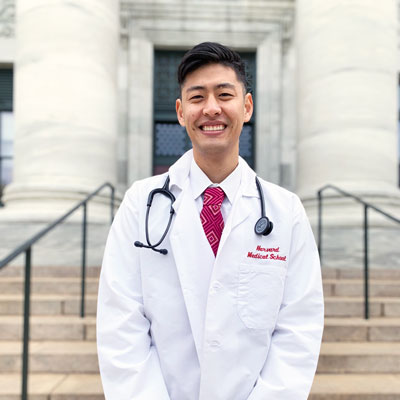
One of his patients became sick with COVID-19 in the shelter she’d been living in, he said. She didn’t want to go back and was asking to be discharged to emergency housing, which wasn’t easy to secure.
“I had zero experience with it,” said Kim. “I talked to the social workers and the attendings to try to figure things out. …There were a lot of people who couldn’t go back home because they lived in a house with multiple people, or they couldn’t provide their own housing or they lost housing. And I think that was the most memorable part about all this is that … even if you’re cleared medically, there was a lot of other issues that compound on getting sick, and not having the support needed. So that’s sad.”
McGrath and Baughman agreed that responding to the intricacies of discharge planning was difficult and required constant contact with and updates from the Boston Health Commission.
“Because it’s stressful to say to this 93-year-old patient, ‘You may return home to your 91-year- old wife.’ To make that call you really want to feel confident that that patient’s no longer infectious,” said Baughman.
The reality of caring for patients without social support networks is what homeless shelter clinicians deal with every day, O’Connell said. It’s devastating for caregivers, he explained, while adding that the disease’s outsized impact on the poor, the destitute and people of color is a problem that “needs to be solved way upstream.”
“We need to really think about, what’s it like to discharge somebody back to the streets into a shelter? We really want to have a better alternative,” said O’Connell. “I think everybody who worked at Boston Hope began to see … where the determinants of health have been ignored by our society for so long, and that we really need to double our efforts. I think Boston Hope became a wonderful lens through which we saw many of the weaknesses in our society.”

Despite wrestling with painful realities at Boston Hope, Kim found his time there an “amazing experience,” and he particularly appreciated the opportunity to practice alongside social workers, nurses and physical and occupational therapists, among others.
“It is impressive how fast things came together and also how well people meshed and worked together. I think people who decided to work there had a very specific goal in mind, to really help people out during the pandemic. It was really cool to see that,” Kim said.
HMS grad Michael Girouard, who received his MD in 2019 and his MBA in 2020, is now doing his residency in internal medicine and primary care at the University of California San Francisco. He is interested in health care systems and delivery and was eager to learn how the clinical management of COVID-19 would play out and to see how the collaborations between the state, the city, the military and various health organizations functioned.
“One of the interesting things I noticed was that the operation was acting kind of like a startup. They were iterating, they were moving quickly, they were trying things, seeing what works and then either keeping them or changing. So, they were acting like a startup but they had all the resources of a large medical center,” said Girouard. “One of the biggest takeaways for me was that innovation thrives in a crisis. People are compelled to act. They can’t wait to jump through all these hoops.”
Baughman and others agreed that one of the most gratifying aspects of working at Boston Hope was the ability to solve problems quickly and efficiently.
“The learning was tremendous and the need was also tremendous,” Baughman said. “There was no time for focusing on what could have been, should have been. It was very future oriented. There was a problem, we had to fix it and we had to fix it quickly and move on.”
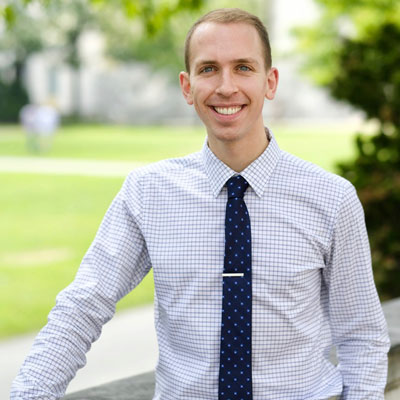
Boland agreed that the collaborative spirit that infused the hospital was remarkable.
“It was all trying to figure this out on the fly, and so we could make very quick decisions in a very collaborative way. Everyone just sort of stepped up into a higher plane and said, ‘We can do this—how can I help?’” he said.
As it was for the other students, one of the most trying aspects for Girouard was seeing patients demoralized by months-long separations from family or other visitors. At the same time, he felt privileged to be able to go to work and interact with other health care professionals in a clinical setting.
“[Students] were there because they wanted to be there. And that was evident in how they showed up each day, how they engaged with the care team, that they took care of patients,” McGrath said. “It was very seamless how they all integrated into it. And it was really cool to see the questions that they had because we had forgotten, when they first started, that none of them had been able to take care of these patients yet.”
Erickson said the presence of the students who worked at Boston Hope was a boon for everyone there, both teachers and patients.
“Very quickly, you could see this learning environment emerging, where students and faculty … it didn’t matter if you were a nursing student, medical student, physical therapy student. Everyone was there to not only help, but also to learn,” she said. “So, to me, that was one of the important contributions that we made. As other health care facilities weren’t able to accommodate students, we very quickly accommodated students.”
“I think these HMS students will be stronger for it,” Boland said. “There’s nothing like having experience to gain confidence, right? And so when the next [pandemic] comes around, if it does, or if they go into global health work, they’ve got that under their belt.”
Debriefing

On June 2, only a few months after Boston Hope first opened its doors, its last few patients were released, sent off by a gathering of clapping, cheering health care workers who would now be returning, at least for the time being, to their regular jobs.
The good-byes were bittersweet. One of the last departing patients was an older, brain-injured homeless man who had endeared himself to the staff by singing throughout his time at Boston Hope, everything from Johnny Cash to Frank Sinatra. His joy at the caregivers’ applause made for an emotional farewell for many of them.
McGrath recalled her conversation with another patient just before he was released.
“I talked to him on his last day as he was packing up and I said, ‘How are you feeling about getting out of here?’ And he said, ‘I’m so glad that I got to be here. I’m so grateful to everybody. I feel like I learned so much while I’ve been here. I’ve had a chance to really think about my life.’”
Beyond the attachments formed with patients, some caregivers knew they would miss their newfound colleagues. Amid the stress and intensity of the work they had performed together at Boston Hope, deep bonds had been forged among these workers whose paths may otherwise never have intersected. In the ongoing war against a vicious virus, they had become foxhole buddies.
“I’m so glad that I did it. Working at Boston Hope was up there as one of the most rewarding experiences I’ve ever had,” McGrath said. “Where you give so much of yourself, but you get way more back in return.
“I think people really found the experience very meaningful and very purpose-driven. And I think for most people this felt like an amazing way to be a part of something huge in our history,” she said, adding that she was beyond proud to have taken part and to have been able to give back to the Boston community.
Baughman said the difficulty of the task seemed to energize caregivers, enabling them to do more than they might be able to under normal circumstances.

“One of the things about the epidemic here was that it really hit a very vulnerable population. So I just felt it was really important to give everything to try to help,” she said. “This is one of those things where, as a physician and health care provider, you train your whole life for this.”
She added, “When this kind of thing happens, you lean in because that’s what you’re trained to do. It’s hard and that’s OK … it might not be intuitive to want to run toward a fire, but the thing about being trained as a physician is that you have a fire suit in some ways. You have training that makes you able to fight the fire.”
Ehrlichman called it “one of the greatest experiences of my life, and I’ve been around a long time.”
He said one of the biggest lessons he learned was how much depth was needed to make such an operation succeed, and he stressed how valuable it was for all involved to understand how all the necessary resources came together, and how they were used and conserved.
“It’s really doing something for your fellow man that’s appreciated,” he said, adding that the experience will provide a valuable guide for the next public health emergency. He has already gotten to work on an after-action report to analyze how the operation performed.
Erickson called the opportunity to work at Boston Hope “a true honor.”
“I would say that the Boston health care community really served the citizens of Massachusetts, and in just a wonderful way,” she said.
Boland is proud that there were no major safety events and no patient deaths at Boston Hope, which he attributed to the stringent quality and safety protocols in place and to the dedication of the many health care workers who came to aid the city in its hour of need.
“Well, we’re very blessed, of course. We’re sort of a medical mecca of the world in a way, right? I mean, if we can’t do it here in Boston, you can’t do it anywhere,” he said.
